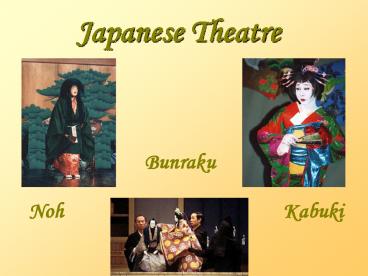Japanese Theatre - PowerPoint PPT Presentation
1 / 38
Title:
Japanese Theatre
Description:
Title: Japanese Theatre Author: jane anderson jones Last modified by: Jones, Jane Created Date: 11/1/1999 6:43:08 PM Document presentation format – PowerPoint PPT presentation
Number of Views:717
Avg rating:3.0/5.0
Title: Japanese Theatre
1
Japanese Theatre
- Bunraku
Noh
Kabuki
2
Noh Drama
3
Noh Drama
- Emerged in the 14th c.
- Frozen in the 17th c.
- Invention attributed to Kanami Kiyotsugu
(1333-1384) - Perfected by his son, Zeami Morokiyo (1363-1443)
4
Noh Drama
- Performed at courts of Ashikaga Shoguns
5
Noh Stage
6
Noh Stage
7
National Noh Theatre, Tokyo 2006
8
Musicians
Hayashikata/JiutaiHayashikata (instrument
players) of whistle, drums, etc. sit at the back
of the stage.
The Jiutai (singers) sit in a line on the left
9
Noh Characters
- Conventional roles in all dramas
- Shite principal character -- the only true
person - Waki secondary character -- introduces story
and asks questions often a priest - Tsure shadowy companion to shiite and/or waki
- Kokata child
- Kyogen clown -- usually lower class
10
Noh Conventions
- Very short, plotless, tragic in mood
- Highly stylized with very slow pace 200-300
lines of play can take an hour to perform - Integrate singing, speech instruments, and
dancing - No limitation in time or space
- Highly allusive, poetic, symbolic language
- Less about characters than emotions
In Aoi no Ue (Lady Aoi), Rokujo, Genjis lover
and the widow of the late crown prince, is
accustomed to more respect than Genji gives her,
and in a rage she sends her spirit to possess
his wife, Aoi. Her jealousy fuels a story of
possession and exorcism.
11
Yugen haunting poetic quality, suggesting
quiet elegance and grace, subtle and fleeting
beauty
12
Types of Noh Plays
- A Days Entertainment contains
- A god play
- A warrior play
- A woman play
- A realistic play
- A demon play
- Kyogen Plays placed between Noh plays as comic
relief - No music
- Broad humor
- About 20 minutes long
A Kyogen play Boshibari (fasten to a bar)
13
Noh Masks
- Female Mask
Male Mask
Demon Mask
Old Man Mask
14
Noh Costumes
Costumes are heavy silk kimonos often
luxuriously embroidered
The ability of the shite and waki to express
volumes with a gesture is enhanced by their use
of various hand properties, the most important of
which is the folding fan (chukei). The fan can be
used to represent an object, such as a dagger or
ladle, or an action, such as beckoning or
moon-viewing.
15
Contemporary Noh performed by firelight at Heian
Shrine in Kyoto
16
Bunraku
17
- Ningyo-joruri, literally puppets and storytelling
- 1684 Takemoto Gidayu set up his own theater in
Osaka - He was helped in his effort by Chikamatsu
Monzaemon, the greatest playwright in Japanese
history, and Takeda Izumo, a famous theater owner
and manager. - Bunraku developed alongside and competed with
Kabuki borrowing of scripts promoted growth of
both Bunraku and Kabuki
18
Puppets
19
Narrator and Shamisen
20
Kabuki
http//ddb.libnet.kulib.kyoto-u.ac.jp/exhibit/okun
i/eng/okuindxe.html
21
1586 Kabuki was invented by a dancing
priestess,Izumono no Okuni
22
Okuni dancing as a samurai in traditional and
modern prints
23
2003 stamps celebrating the 400th anniversary
of Kabuki
Kabuki plays
Okuni Kabuki Screen
24
- Kabuki was popular theatre with a greater
emphasis on plot, conflict and excitement than
Noh
25
Kabuki Theatre
- 1629 Shoguns forbid females to appear on stage
young boys played their roles - 1652 Young boys forbidden to play female roles
- 1983 An all-female Kabuki troupe is formed
Nagoya Musume Kabuki
26
Nagoya Musume Kabuki
27
Kabuki Stage
28
Kabuki Stage
1. Mawari-Butai Turntable used to change
scenes. Invented by Japanese first used in
Kabuki 2. Oh-Zeri King sized elevator used to
bring scenery from cellar to stage 3. Seri lift
for actors and sets 4. Geza stage left/ Music
box Place where music and sound effects are
produced 5. Yuka Narration stage Narrators
playing place 6. Hana-michi Flower Path/ Stage
Road 7. Suppon lift where monsters appear
9. Kara Hana-michi Sub-stage Road
8. Toya Waiting Room
29
Kabuki Staging
- Geza Musicians samisen, percussion, winds,
voices - O-dugu Stage sets traps, lifts, revolving
stages - Ko-dugu Properties
- Afuri-kaeshi spectacular set changes
30
Kabuki Characters
31
Kabuki Characters
32
Onnagata femalesplayed by male actors.The
ideal for the onnagata is not to imitate women
but to symbolically express the essence of the
feminine.
33
Aragotavigorous heroes
34
Tatevirtuous hero Katakivillain Dokicomic
Rojinold man
Tachi Yaku males
35
Kodomo children
36
Kabuki Style
- Kata stylized movement patterns
- Onnagata female characters
- centerpiece dance
- super feminine
- Tachiyaku Male character roles
- Aragota style rough style
- superman type characters
- Kumadori makeup
- Mie poses with glaring crossed eyes
- Wagoto soft style
- refined, merchants sons who fall in love with
beautiful courtesans - disowned by families
- somewhat comic
37
Kabuki Conventions
- Hanamichi flower path
- Mawari-butai revolving stage rapid scene
shifts - Tyobo drums indicating play was adapted from
Bunraku - Geza inconspicuous music box -- samisen
- Debayasi onstage orchestra during dance
- Kurogo assistant dressed in black who aids
actors
38
Types of Kabuki Plays
- Aragota vigorous hero plays
- Shiranami-mono lives of thieves plays
- Koroshi-ba feudal plays with many kill scenes
- Tachi-Mawari the fight
- Seasonal plays
- New Years revenge play
- April Hanami Tsuki flower viewing -- court
ladies - Summer ghost plays
- December Shibakaku plays to introduce new
actors - Aiso-zukashi scorned love plays
- Engiri break-up scene
- Suicide Pact plays

